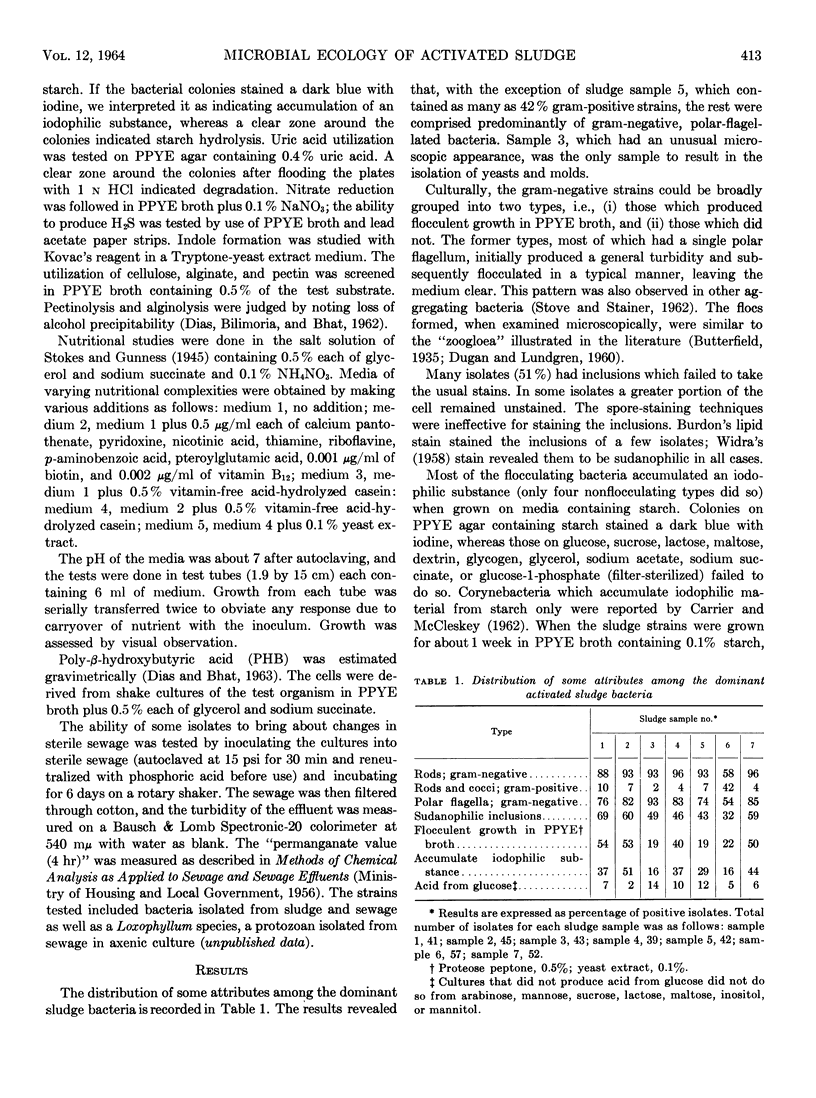Abstract
Over 300 bacterial strains were isolated from seven samples of activated sludge by plating on sewage agar. Gram-negative bacteria of the genera Zoogloea and Comamonas predominated. Many isolates (51%) showed sudanophilic inclusions of poly-β-hydroxybutyric acid, whereas 34% accumulated iodophilic material on media containing starch. A large number required either vitamins or amino acids, or both, for growth. None of the isolates tested for their ability to bring about changes in autoclaved sewage produced an effluent comparable in quality to the activated sludge control, although the Zoogloea did produce activated sludgelike flocs. A study of 150 bacterial strains isolated from raw sewage revealed that they differed from the sludge isolates in several respects. Coliforms, which constitute nearly a quarter of the sewage isolates, were rarely encountered in sludge.
Full text
PDF





Selected References
These references are in PubMed. This may not be the complete list of references from this article.
- CARRIER E. B., McCLESKEY C. S. Intracellular starch formation in corynebacteria. J Bacteriol. 1962 May;83:1029–1036. doi: 10.1128/jb.83.5.1029-1036.1962. [DOI] [PMC free article] [PubMed] [Google Scholar]
- DAVIS G. H., PARK R. W. A taxonomic study of certain bacteria currently classified as Vibrio species. J Gen Microbiol. 1962 Jan;27:101–119. doi: 10.1099/00221287-27-1-101. [DOI] [PubMed] [Google Scholar]
- DOUDOROFF M., STANIER R. Y. Role of poly-beta-hydroxybutyric acid in the assimilation of organic carbon by bacteria. Nature. 1959 May 23;183(4673):1440–1442. doi: 10.1038/1831440a0. [DOI] [PubMed] [Google Scholar]
- DUGAN P. R., LUNDGREN D. G. Isolation of the floc-forming organism Zoogloea ramigera and its culture in complex and synthetic media. Appl Microbiol. 1960 Nov;8:357–361. doi: 10.1128/am.8.6.357-361.1960. [DOI] [PMC free article] [PubMed] [Google Scholar]
- HUGH R., LEIFSON E. The taxonomic significance of fermentative versus oxidative metabolism of carbohydrates by various gram negative bacteria. J Bacteriol. 1953 Jul;66(1):24–26. doi: 10.1128/jb.66.1.24-26.1953. [DOI] [PMC free article] [PubMed] [Google Scholar]
- LEVINE H. B., WOLOCHOW H. Occurrence of poly-beta-hydroxybutyrate in Pseudomonas pseudomallei. J Bacteriol. 1960 Feb;79:305–306. doi: 10.1128/jb.79.2.305-306.1960. [DOI] [PMC free article] [PubMed] [Google Scholar]
- McKINNEY R. E., WEICHLEIN R. G. Isolation of floc-producing bacteria from activated sludge. Appl Microbiol. 1953 Sep;1(5):259–261. doi: 10.1128/am.1.5.259-261.1953. [DOI] [PMC free article] [PubMed] [Google Scholar]
- ROGOVSKAIA Ts I., LAZAREVA M. F. [Intensification of biochemical processes in the purification of industrial sewage. I. Microbiological characteristics of active silts purifying various types of industrial sewage]. Mikrobiologiia. 1959 Jul-Aug;28:565–573. [PubMed] [Google Scholar]
- ROUF M. A., STOKES J. L. Isolation and identification of the sudanophilic granules of Sphaerotilus natans. J Bacteriol. 1962 Feb;83:343–347. doi: 10.1128/jb.83.2.343-347.1962. [DOI] [PMC free article] [PubMed] [Google Scholar]
- SIERRA G., GIBBONS N. E. Role and oxidation pathway of poly-beta-hydroxybutyric acid in Micrococcus halodenitrificans. Can J Microbiol. 1962 Apr;8:255–269. doi: 10.1139/m62-032. [DOI] [PubMed] [Google Scholar]
- WIDRA A. Metachromatic granules of microorganisms. J Bacteriol. 1959 Nov;78:664–670. doi: 10.1128/jb.78.5.664-670.1959. [DOI] [PMC free article] [PubMed] [Google Scholar]
- WILLIAMSON D. H., WILKINSON J. F. The isolation and estimation of the poly-beta-hydroxybutyrate inclusions of Bacillus species. J Gen Microbiol. 1958 Aug;19(1):198–209. doi: 10.1099/00221287-19-1-198. [DOI] [PubMed] [Google Scholar]


